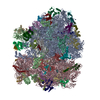+Search query
-Structure paper
| Title | A new family of bacterial ribosome hibernation factors. |
|---|---|
| Journal, issue, pages | Nature, Vol. 626, Issue 8001, Page 1125-1132, Year 2024 |
| Publish date | Feb 14, 2024 |
 Authors Authors | Karla Helena-Bueno / Mariia Yu Rybak / Chinenye L Ekemezie / Rudi Sullivan / Charlotte R Brown / Charlotte Dingwall / Arnaud Baslé / Claudia Schneider / James P R Connolly / James N Blaza / Bálint Csörgő / Patrick J Moynihan / Matthieu G Gagnon / Chris H Hill / Sergey V Melnikov /    |
| PubMed Abstract | To conserve energy during starvation and stress, many organisms use hibernation factor proteins to inhibit protein synthesis and protect their ribosomes from damage. In bacteria, two families of ...To conserve energy during starvation and stress, many organisms use hibernation factor proteins to inhibit protein synthesis and protect their ribosomes from damage. In bacteria, two families of hibernation factors have been described, but the low conservation of these proteins and the huge diversity of species, habitats and environmental stressors have confounded their discovery. Here, by combining cryogenic electron microscopy, genetics and biochemistry, we identify Balon, a new hibernation factor in the cold-adapted bacterium Psychrobacter urativorans. We show that Balon is a distant homologue of the archaeo-eukaryotic translation factor aeRF1 and is found in 20% of representative bacteria. During cold shock or stationary phase, Balon occupies the ribosomal A site in both vacant and actively translating ribosomes in complex with EF-Tu, highlighting an unexpected role for EF-Tu in the cellular stress response. Unlike typical A-site substrates, Balon binds to ribosomes in an mRNA-independent manner, initiating a new mode of ribosome hibernation that can commence while ribosomes are still engaged in protein synthesis. Our work suggests that Balon-EF-Tu-regulated ribosome hibernation is a ubiquitous bacterial stress-response mechanism, and we demonstrate that putative Balon homologues in Mycobacteria bind to ribosomes in a similar fashion. This finding calls for a revision of the current model of ribosome hibernation inferred from common model organisms and holds numerous implications for how we understand and study ribosome hibernation. |
 External links External links |  Nature / Nature /  PubMed:38355796 / PubMed:38355796 /  PubMed Central PubMed Central |
| Methods | EM (single particle) |
| Resolution | 2.6 - 3.1 Å |
| Structure data | EMDB-19067, PDB-8rd8: EMDB-19076, PDB-8rdv: EMDB-19077, PDB-8rdw: EMDB-43074, PDB-8v9j: EMDB-43075, PDB-8v9k: EMDB-43076, PDB-8v9l:  EMDB-43077: Cryo-EM structure of the Mycobacterium smegmatis 70S ribosome in complex with hibernation factor Msmeg1130 (Balon) and MsmegEF-Tu(GDP) (Structure 6)  EMDB-43078: Hibernation factor Msmeg1130 (Balon) and MsmegEF-Tu(GDP) bound to Mycobacterium smegmatis 70S ribosome, from focused 3D classification and refinement (Structure 6) |
| Chemicals |  ChemComp-MG:  ChemComp-GDP:  ChemComp-HOH:  ChemComp-ZN: |
| Source |
|
 Keywords Keywords |  RIBOSOME / Hibernation factor / Dormancy / Balon / RIBOSOME / Hibernation factor / Dormancy / Balon /  cryo-EM / cryo-EM /  mycobacteria / mycobacteria /  hibernation / Msmeg1130 / Rv2629 / MsmegEF-Tu hibernation / Msmeg1130 / Rv2629 / MsmegEF-Tu |
 Movie
Movie Controller
Controller Structure viewers
Structure viewers About Yorodumi Papers
About Yorodumi Papers















 psychrobacter urativorans (bacteria)
psychrobacter urativorans (bacteria)